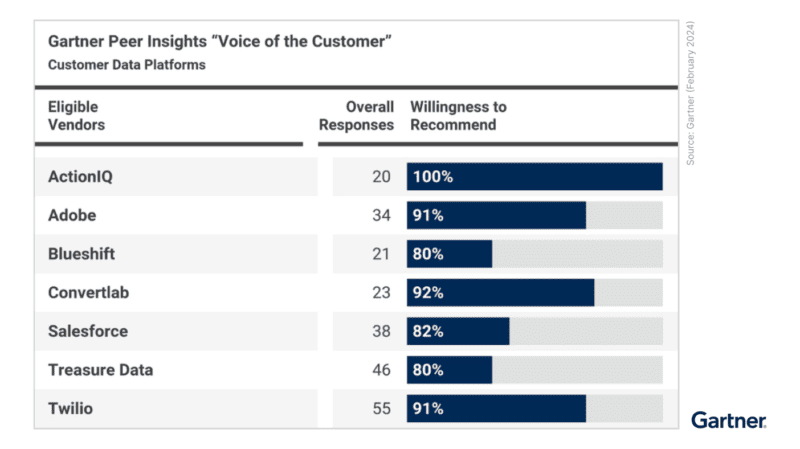Saks Embraces Data Freedom and Flexibility with Composability

Good things don’t always come to those who wait — especially not in retail marketing.
In an economy plagued by financial uncertainty, and an environment defined by change in data protocol and practice, brands need to design systems, strategies and surroundings that provide scale and flexibility with governance and control.
That’s why leading luxury brand Saks partners with a composable data infrastructure and data cloud Snowflake to look ahead with confidence, and make every anonymous visitor their next brand champion.
We joined CIO Dive for a conversation with Nivy Swaminathan, Vice President of Advanced Analytics and Personalization with Saks and Patrick Crosby, lead of Technology Alliances with Snowflake to explore how composability is giving marketing teams the freedom to test, learn and drive customer outcomes at scale, while giving IT and analytics teams the governance and control they need to keep their data secure — all while saving their teams tons of time.
Watch the full webinar here and keep reading for our takeaways.
How a CDP Emerged as a Key Piece of Saks’ Stack
For Saks, data is incredibly powerful. Whether your organization is big or small, customers should always be at the heart of your analytics and marketing strategies. Data empowers team members across the organization to make decisions that are always smarter and better, through both success and failure. But in order to unlock that data-driven strategy, you need the tools that will democratize and activate that data-driving decisioning and action — from the analytics team all the way to the marketers and beyond.
CDPs are designed to act at the center of each source of data, and connect all of that customer data to the marketing channels, so that customer data can be used by the marketing teams, by the customer experience teams — the folks that are are tasked with building and powering that customer experience to drive the business.
Michael Trapani, ActionIQ
Beyond that, CDPs solved Saks’ need to create well-governed data infrastructure, in a way that leaves little room for mistakes, while putting that data directly in the hands of team members that aren’t necessarily well-versed in SQL and programming tools.
But not just any CDP would fill that order. They needed a solution that would give them the freedom to scale that entire experience, and evolve as quickly as the retail environment evolves.
How CDPs Evolved from Bundled to Composable
Traditional bundled CDPs are struggling because they come with some serious baggage for brands. They don’t integrate with those large customer 360 projects, they are disconnected and lack the right integrations, and they don’t really have the scale that a lot of newer data cloud systems have. Alongside those frustrations is the transition from reliance on third-party cookies to first-party data. Organizations that are attuned to that are adopting CDPs with real intentionality.
Patrick explains that CDPs are evolving with the needs of organizations. Some of the things we’re seeing are people that are heavily infested in cloud data infrastructure and using cloud platforms like Snowflake as their data center of gravity. So it makes sense, in a lot of cases, for organizations to be able to build their CDP on top of that, and leverage that source of data to access and activate those insights. We’re seeing new capabilities and opportunities for that solution with composability.
The need to move beyond the limitations of a traditional CDP is real for many companies, which is why we’re now seeing a new strategy that offers a modern future-proof CX stack built from composable solutions decouples your marketing tool set from the infrastructure layer, and gives you architectural flexibility while powering critical marketing outcomes.
This evolution from bundled to composable goes beyond the need to meet changing security requirements — it also offers flexibility in integration and activation, to select those features that create the best stack for each organization’s infrastructure and give room for future growth and change.
We’re inherently wired to think about the future and drive that behavior, which all starts with the customer. And so I think the CDP is a very, very key piece of our modern tech stack that has been able to keep up with the changing basis of the environment and the industry, and be able to evolve alongside it.
Nivy Swaminathan, Saks
How Composability Gives Saks Flexibility and Scale
Composable CDPs were built in response to this demand for evolution to become purpose-built for the modern data stack. Composable CDPs map directly to the data cloud, embracing this single source of truth with clouds like Snowflake, that are the central data hubs for enterprise organizations.
Instead of making copies and shipping it off to a separate CDP, the CDP computes directly where the data lives. Then the marketing team can have self-serve access, with what happens in the background making all the difference with access to more data and better customer experiences.
The other pieces, privacy and security, which are extremely important, are increasingly more important now. This provides a clean way in which you can have governed use of data, you do not need to have identifiable information about customers floating in every system, you can keep that under lock and key and still allow the marketers to do their thing by giving them access to the UI and have version control on the data.
Nivy explains that CDPs are joined at the hip with the company’s overall data strategy. They offer a ton of flexibility to future-proof the program, because you will always be able to use your own data, which is your first-party data in every way that will improve your business. The composable CDP path allows you to do that by giving you enough freedom to still have your marketers move at their own speed.
ActionIQ helped us elevate the analytic maturity of the organization, and allowed us to do a lot of nimble casting — and put data to the test with facts from the past and predictive attributes that enrich customer data all in one, easy-to-access location.
Nivy Swaminathan, Saks
The Composable CDP in Action for Saks
Saks’ data is all in Snowflake, where it’s managed by Nivy’s team. They build data science models, predicting outcomes at a user level, and all of that rich data gets written back into their Snowflake data system. ActionIQ mirrors that work to allow marketers access and activation of all of those insights-driven audiences. With ActionIQ, Saks activates audiences in 10 channels (and growing) through integrations, with first-party data as a signal to activate on different platforms.
The return from having a CDP for Saks manifested in time-savings, agility to rapidly test, learn and optimize on data-driven insights and audiences, and self-service for their marketing teams.
As I look back over the last 10 years at Saks, there are many, many tools that we’ve added to our martech stack. I can safely say, I think the CDP has been one of our wisest investments, because of the return that it’s been able to offer us that we can measure tangibly, the activations that we’re doing with all of these campaigns, and the use of first-party data. But also in terms of people and resources, and how as an organization, we’ve been able to be so data-driven within the marketing teams, which is the function that is frontline for customers where you’re, at least in the retail world, inspiring people to make a purchase.
Nivy Swaminathan, Saks
Go From Anonymous Browser to Brand Champion
Customers will always be at the heart of Saks’ strategy — and the more data you’re able to action on, the better experience customers will have.
At the end of the day, shoppers won’t wait for brands to catch up to the cutting-edge personalization they expect (cookiepocalypse or not). With a composable approach, brands like Saks can take control of the customer data that shoppers are sharing to create memorable, amazing experiences across each shoppers’ lifecycle.
Talk to us to learn about how you can apply ActionIQ’s CDP to take your customers from anonymous browsers to brand champions.





